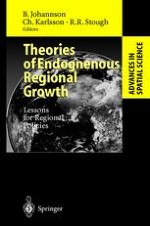2001 | OriginalPaper | Buchkapitel
Agglomeration, Enterprise Size, and Productivity
verfasst von : Edward J. Feser
Erschienen in: Theories of Endogenous Regional Growth
Verlag: Springer Berlin Heidelberg
Enthalten in: Professional Book Archive
Aktivieren Sie unsere intelligente Suche, um passende Fachinhalte oder Patente zu finden.
Wählen Sie Textabschnitte aus um mit Künstlicher Intelligenz passenden Patente zu finden. powered by
Markieren Sie Textabschnitte, um KI-gestützt weitere passende Inhalte zu finden. powered by
Much research on agglomeration economies, and particularly recent work that builds on Marshall’s concept of the industrial district, postulates that benefits derived from proximity between businesses are strongest for small enterprises (Humphrey, 1995; Sweeney and Feser, 1998). With internal economies a function of the shape of the average cost curve and level of production, and external economies in shifts of that curve, a small firm enjoying external economies characteristic of industrial districts (or complexes or simply urbanized areas) may face the same average costs as the larger firm producing a higher volume of output (Oughton and Whittam, 1997; Carlsson, 1996; Humphrey, 1995). Thus we observe the seeming paradox of large firms that enjoy internal economies of scale co-existing with smaller enterprises that should, by all accounts, be operating below minimum efficient scale. With the Birch-inspired debate on the relative job- and innovation-generating capacity of small and large firms abating (Ettlinger 1997), research on the small firm sector has shifted to an examination of the business strategies and sources of competitiveness of small enterprises (e.g., Pratten, 1991; Nooteboom, 1993). Technological external scale economies are a key feature of this research (Oughton and Whittam, 1997).
